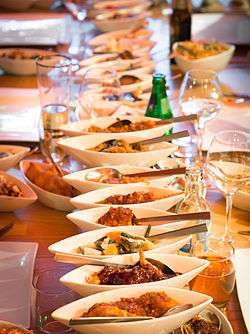Rijsttafel
|
An elaborate rijsttafel in a restaurant in The Hague, Netherlands | |
| Alternative names | Rice table |
|---|---|
| Course | Main course |
| Place of origin | Dutch East Indies (19th-early 20th century Indonesia) |
| Region or state | Java |
| Creator | Colonial Indonesian cuisine |
| Serving temperature | Hot or room temperature |
| Main ingredients | Rice with various side dishes |
| Variations | Nasi campur, Nasi Rames (Indo) |
| Other information | It is more a lavish banquet than a dish, popular in the Netherlands |
|
| |


The Indonesian rijsttafel (Dutch pronunciation: [ˈrɛisttaːfəl]), a Dutch word that literally translates to "rice table", is an elaborate meal adapted by the Dutch following the hidang presentation of Nasi Padang from the Padang region of West Sumatra.[1] It consists of many (forty is not an unusual number) side dishes served in small portions, accompanied by rice prepared in several different ways. Popular side dishes include egg rolls, sambals, satay, fish, fruit, vegetables, pickles, and nuts. In most areas where it is served, such as the Netherlands, and other areas of heavy Dutch influence (such as parts of the West Indies), it is known under its Dutch name.
Although the dishes served are undoubtedly Indonesian, the rijsttafel’s origins were colonial. During their presence in Indonesia, the Dutch introduced the rice table not only so they could enjoy a wide array of dishes at a single setting but also to impress visitors with the exotic abundance of their colony.[2]
Rijsttafels strive to feature an array of not only flavors and colors and degrees of spiciness but also textures, an aspect that is not commonly discussed in Western food. Such textures may include crispy, chewy, slippery, soft, hard, velvety, gelatinous, and runny.
History
The Dutch colonial feast, the rijsttafel, was created to provide a festive and official type of banquet that would represent the multi-ethnic nature of the Indonesian archipelago. Dishes were assembled from many of the far flung regions of Indonesia, where many different cuisines exist, often determined by ethnicity and culture of the particular island or island group — from Javanese favourite sateh, tempeh and seroendeng, to vegetarian cuisine gado-gado and lodeh with sambal lalab from Batavia and Preanger. From spicy rendang and gulai curry from the Minangkabau region in Sumatra, to East Indies ubiquitous dishes nasi goreng, soto ayam and kroepoek crackers. Also Indonesian dishes from hybrid influences; such as Chinese babi ketjap, loempia and bamie to European beef smoor. And there are many others from the hundreds of inhabited islands, which contain more than 300 regional and ethnic language groups.
During its centuries of popularity in Dutch East Indies, lines of servants or sarong-clad waitresses ceremoniously served the marathon meal on platters laden with steaming bowls of fragrant foods. The first to be served was a cone-shaped pile of rice on a large platter, which the server placed in the center of the table. The servers then surrounded the rice platter with as many as 40 small bowls holding meat and vegetable dishes as well as condiments. During its colonial heyday, the most celebrated rijsttafel in the Indies was served for Sunday luncheon at the Hotel des Indes in Batavia and the Savoy Homann Hotel in Bandung, where the rice was accompanied by sixty different dishes.[3]
Brought back to the Netherlands by former colonials and exiled Indonesians and Indo-Europeans (Eurasians) after Indonesia gained its independence in 1945, the rijsttafel was predominantly popular with Dutch families with colonial roots. On the other hand, in Indonesia, when the country proclaimed its independence in 1945, Indonesian nationalism increased among its people, and this sentiment projected through the rejection of Dutch colonial culture and customs, including the flamboyant rice table. Today, the rice table has practically disappeared from Indonesia's restaurants and is served only by a handful of fine-dining restaurants in Indonesia.
More of a banquet than a meal, the rijsttafel has survived Indonesia's independence, composed as it is of indigenous Indonesian dishes, and is served in some mainstream restaurants in Indonesia. A typical rijsttafel will have several dining tables covered with different dishes; while in some fancy settings in Indonesia, each dish may be served by a separate waitress. Since about 1990, Indonesian food has become part of a mainstream interest in South East Asian cuisine, and there has been a proliferation of Indonesian restaurants in the Netherlands.
Typical dishes
The following is a brief, but not nearly complete, list of examples of foods that may be found on a rijsttafel:
- Babi kecap – Pork belly braised in sweet soy sauce common in the Netherlands, for halal Indonesian version often replaced by beef semur
- Bebek betutu – Duck roasted in banana leaves
- Gado-gado – Vegetables (cooked or fresh) with peanut sauce (sambal kacang)
- Krupuk – Shrimp crackers
- Lumpia – Spring rolls
- Nasi goreng – Fried rice
- Nasi kuning – Indonesian yellow rice
- Perkedel – Meat and potato patties
- Pisang goreng – Banana fritters
- Sambal iris – Onion, tomato and chilli paste
- Sambal kacang – Peanut sauce
- Sambal ulek – Spicy chilli paste
- Satay (sometimes spelled Saté, Sate, or Sateh) – Various thinly sliced meats, marinated then broiled on a skewer, such as: Sate Ayam, chicken; Sate Babi, pork; Sate Lilit, seafood
- Semur daging – A type of stew of beef braised in sweet soy sauce
- Serundeng – Peanuts with sautéed shredded coconut
- Tahu telur – Tofu omelette
- Telur balado – Hard-boiled eggs sautéed in chilli sauce
- Sayur lodeh – Vegetable stew (spicy) in coconut milk
- Rendang – Aromatic spicy caramelized beef, braised in coconut milk, chillies and spices
- Lemper – Rice rolls with spicy filling
- Opor ayam – Chicken coconut curry
Today

Despite its popularity in the Netherlands and abroad, the rijsttafel is rarely found in Indonesia. That is probably because most Indonesian meals consist of rice accompanied by only one, two or three dishes, mostly consisting of lauk (fish, chicken, meat, egg or other source of protein), sayur (vegetable) and other side dishes. To consume more than that number of dishes at once (note: the rice table might range from seven to forty dishes) is considered too extravagant and too expensive. The closest versions to rice table readily available in Indonesia are local Nasi Padang and nasi campur. However, in Indonesian restaurants around the world, especially in the Netherlands and South Africa, the rijsttafel is still popular.
Today only a handful of dining establishments in Indonesia ceremoniously serve elaborate colonial-style rijsttafel. In July 2011, Garuda Indonesia launched Indonesian rijsttafel in Executive Class as its signature in-flight service.[4] This Indonesian signature dining was meant to introduce the passenger to a wide array of Indonesian cuisine in a single setting as part of Garuda Indonesia experience. This in-flight Indonesian rijsttafel includes Indonesian signature dishes; choices of nasi kuning or regular steamed rice, accompanied with choices of dishes such as satay, rendang, gado-gado grilled chicken rica, red snapper in yellow acar sauce, fried shrimp in sambal, potato perkedel and tempeh, also with kerupuk or rempeyek crackers.[5] [6]
See also
References
- ↑ What is rijsttafel?
- ↑ Bob Martin: The Rise and Fall of Indonesia's Rice Table
- ↑ Fadly Rahman (16 December 2010). "Rijsttafel: The History of Indonesian Foodways". Kompasiana. Kompasiana. Retrieved 28 July 2013.
- ↑ New TV Commercial : Discover our Signature In-flight Service with Revitalized Fleet Archived May 16, 2012, at the Wayback Machine.
- ↑ Rijsttafel di Udara
- ↑ All new Garuda Indonesia Experience 2011 Commercial
Further reading
- Hulupi, Maria Endah. "Rijstafel: finding enough room for all those dishes" (Archive). The Jakarta Post. October 29, 2003.
External links
-
 Media related to Rijsttafel at Wikimedia Commons
Media related to Rijsttafel at Wikimedia Commons
